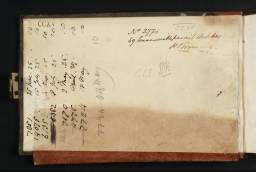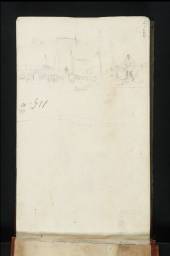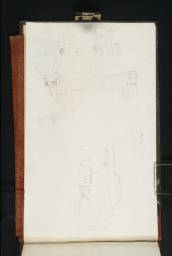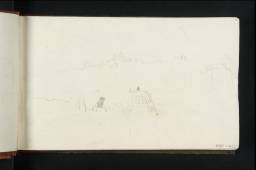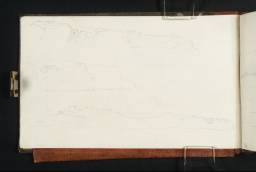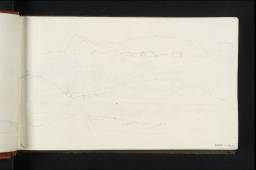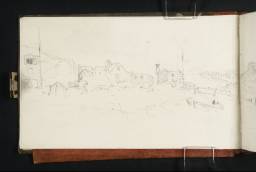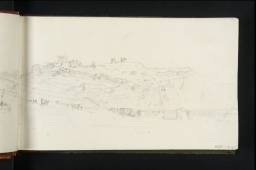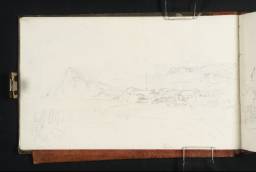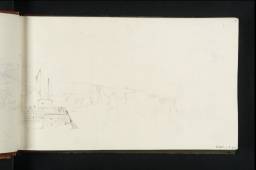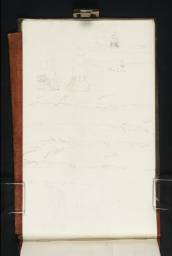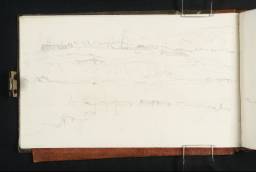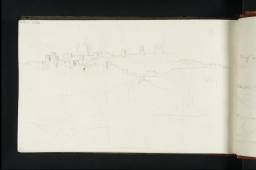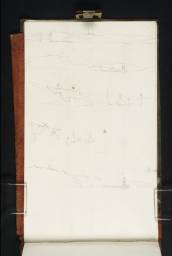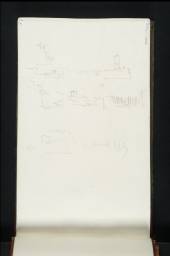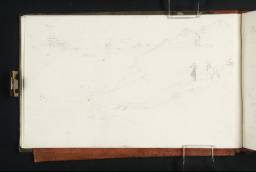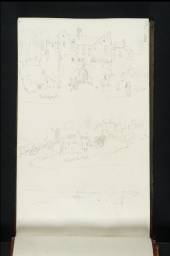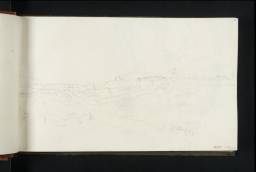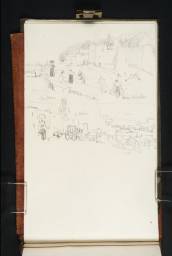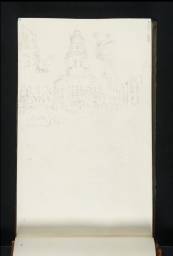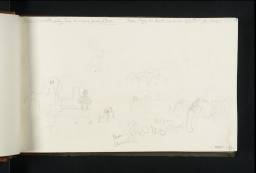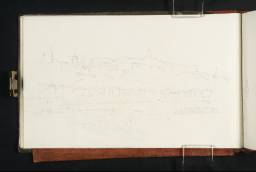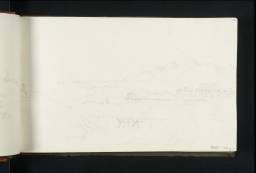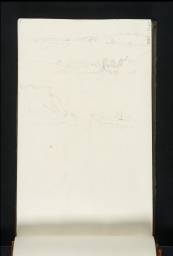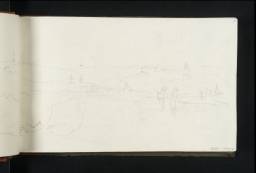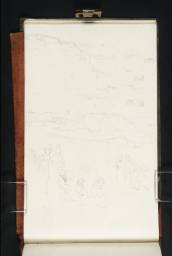Sketchbook, bound in boards, covered in grey paper quarter-bound over brown leather spine; one brass clasp; leather pencil holder along bottom edge of front cover
90 leaves (including folio 88, D19546–D19547, incorporated in error from another sketchbook, and eighteen blank modern replacements) and paste-downs of white wove paper; page size 113 x 189 mm; watermark ‘Allee | 1819’
Made by William Allee of Hurstbourne Prior Mill, Hampshire
Inscribed by Turner in ink ‘MEUSE’ directly on leather spine (D41011)
Numbered 277 as part of the Turner Schedule in 1854 and endorsed by the Executors of the Turner Bequest inside front cover (D41012)
Blind-stamped with Turner Bequest monogram towards top left of front cover, on leather spine cloth
Stamped in black ‘CCXV’ top right of the front cover
90 leaves (including folio 88, D19546–D19547, incorporated in error from another sketchbook, and eighteen blank modern replacements) and paste-downs of white wove paper; page size 113 x 189 mm; watermark ‘Allee | 1819’
Made by William Allee of Hurstbourne Prior Mill, Hampshire
Inscribed by Turner in ink ‘MEUSE’ directly on leather spine (D41011)
Numbered 277 as part of the Turner Schedule in 1854 and endorsed by the Executors of the Turner Bequest inside front cover (D41012)
Blind-stamped with Turner Bequest monogram towards top left of front cover, on leather spine cloth
Stamped in black ‘CCXV’ top right of the front cover
Accepted by the nation as part of the Turner Bequest 1856
Exhibition history
References
This landscape-format sketchbook was used along with the smaller, upright Holland book (Tate; Turner Bequest CCXIV) in what are today the Netherlands, Germany and Belgium (the first and last then forming the United Kingdom of the Netherlands), as well as the adjacent northern coast of France, in the early autumn of 1825.
Only seven Continental cities are included in it, albeit in considerable detail, and all are complemented by sketches among the much more extensive range of subjects covered in its companion. Cecilia Powell has noted that this time ‘it is probable that Turner deliberately followed his practice of 1824 [see below] in taking with him a small upright book ... for note-taking and smaller sketches and a larger horizontal one ... for more extensive views and more detailed studies’;1 compare respectively the previous year’s Rivers Meuse and Moselle and Huy and Dinant sketchbooks (Tate; Turner Bequest CCXVI, CCXVII).
Together, this and the Holland sketchbook comprise the only direct evidence of the 1825 tour, apart from Turner’s professed decision to embark on it shortly beforehand, as set out in the Introduction to the other book. Since the latter encompasses the entire journey, its immediate circumstances, full itinerary and outcomes, along with previous Turner scholars’ commentaries, are dealt with there in more detail than in the tour’s overall Introduction.
As outlined in the technical notes below, like many others this sketchbook was taken apart during John Ruskin’s initial assessment of the Turner Bequest for the potential mounting and display of individual pages, although in the event none of those here appear to have been treated in this way. Finberg’s 1909 Inventory followed the sequence of the ink folio numbers inscribed by Ruskin. By then, fifteen leaves were noted as missing or likely ‘the blank leaves found (unnumbered) within the covers’,2 and when the sketchbook was rebound at the British Museum in 1939, three more (listed as blank in 1909) had gone astray, and all were replaced with modern paper, retaining Ruskin’s numbered order.
There is a brief sequence of sketches at Dover on the first few leaves as foliated (see under folio 1 recto; D19401); Finberg suggested of the view of the nearby coast from the sea on folio 5 verso (D19410): ‘Perhaps this is on the return journey’.3 Short continuous runs in and around the various Continental cities, some treated in double-page spreads with occasional panoramic extensions onto adjacent pages, follow, but four subjects recur at intervals towards both ends.
Ruskin’s numbering appears unreliable and can effectively be disregarded in terms of tracing Turner’s straightforward, continuous itinerary as inferred from the undisturbed Holland book. It caused Finberg some confusion, for example leading him to suggest one distant view of Maastricht as showing Boulogne (folio 21 verso; D19438) by association with adjacent sketches of the latter, and confidently identifying one Liège view, falling between others wrongly and correctly identified as Cologne, as showing the fortress of Ehrenbreitstein, further south up the Rhine (folio 29 verso; D19454), which Turner did not pass on this tour. Maurice Guillaud took the order at face value and assumed that Turner’s tour began and ended at Boulogne,4 rather than starting at Rotterdam, as the Holland book suggests.
Key entries are set out below in the order the cities were visited, with cross-references to the Holland pages under which drawings from other tours and the subjects’ wider significance are discussed. It seems that Maastricht was only visited on this occasion:
A notional rearrangement of the leaves, bringing the discrete subjects into more coherent groupings, is set out in the technical notes. Also discussed there, the sketchbook’s biggest anomaly (originating with Ruskin and perpetuated in the 1909 Inventory) is folio 88 (D19546–D19547), with previously unrecognised sketches of Edinburgh on both sides, which had gone astray from a similar Scottish sketchbook of 1818. Its presence necessitates the two dates applied to the present book as a whole.
In the Inventory, Finberg dated the Holland book to 1825,5 and this one to approximately the same time, presumably partly on account of the list of banknotes dated between April and August 1825 inside the front cover (D41012).6 However, in an unpublished annotation he suggested that its date was ‘Probably 1826’,7 linking it by implication with other sketchbooks since redated to 1824;8 see the tour’s Introduction for the broader context. In his subsequent biography of the artist, he did not mention it, asserting that the ‘only record we possess of this tour is contained in the “Holland” sketchbook’.9 Gerald Wilkinson thought the present book was ‘probably’ from 1826.10 Having initially assigned it to ‘August–September 1825’,11 Andrew Wilton adopted the later year in his comprehensive 1987 chronology of Turner’s tours,12 along with others which Cecilia Powell established in 1991 as belonging to 182413 (see Alice Rylance-Watson’s ‘Meuse-Mosel, Luxembourg and Northern France 1824’ section in the present catalogue). Wilton subsequently transferred this one to 1825,14 as Powell had conclusively demonstrated that it and Holland were used in combination, and others before and since have concurred.15
Martin Butlin and Evelyn Joll linked the Cologne sketches here (‘especially’ folio 33 recto; D19460) and in the Holland sketchbook to ‘Turner’s visit in September 1825’16 in relation to the major painting Cologne, the Arrival of a Packet Boat. Evening, exhibited at the Royal Academy the following year (Frick Collection, New York),17 although the viewpoints in the painting and D19460 are quite different; its more direct sources are noted under Tate D19122 (Turner Bequest CCXIV 143) in the Holland book. As discussed in the latter’s Introduction, Cologne had perhaps not been specified by the existing patron who eventually acquired the painting, which was possibly not a direct commission, so Turner may have been surveying potential alternatives in commensurate detail, but did not go on to develop any other finished compositions.
About a fifth of the long Holland book comprises studies around Dover and other locations along the Kent coast which can be related to watercolours engraved in 1826 for the last instalments of the long-running Picturesque Views on the Southern Coast of England. It is possible that folios 2 verso and 7 recto here (D19404, D19413) informed the currently untraced design18 published as Dover from Shakespeare’s Cliff (Tate impressions: T04424, T05246–T05251, T06000). Meanwhile, folios 2 recto and 4 recto (D19403, D19407) may have had a bearing on another watercolour, Dover (Tate D18154; Turner Bequest CCVIII U),19 which was engraved in 1827 for the Ports of England (Tate impressions: T04828–T04829).
Wilkinson suggested that the ‘drawings at Boulogne (folios 11a, 80a [D19420, D19537]), have a happy quality of colour and contrast. This book is of good wove paper with a pleasant “bite” in the surface, and his pencil is softer than usual.’20 Taking a panorama of the churches of Liège (folios 25 verso–26 recto; D19446–D19447) as a case study, Powell has observed:
Besides its admirably precise depiction of buildings in many different architectural styles, Turner’s drawing is also notable for his varied use of the pencil. Throughout the sketch innumerable touches – dark and light, sharp and blunt, firm and gentle – are consistently interwoven and tiny patches of hatching are also introduced, so that the viewer is aware not only of the volume of the buildings but also the play of light and shade on their surfaces.21
She continued: ‘While the majority of the sketches Turner drew on his foreign tours served chiefly as prosaic memoranda ... others – such as this one – can stand on their own as evidence of Turner’s genius.’22
As set out in the technical notes which follow, some of the separated leaves were initially placed by Ruskin in a ‘parcel’ labelled ‘Rhine. 277’, the book’s original 1854 Turner Schedule number.23 Finberg did not incorporate that river’s name in the title adopted for the 1909 Inventory, instead expanding on ‘MEUSE’, which Turner had written directly on the leather spine (D41011). Undated MS notes by Finberg (died 1939) and the Turner scholar C.F. Bell (died 1966) in copies of the Inventory (Prints and Drawings Room, Tate Britain) on the subjects of individual drawings are quoted in relevant entries.
Many of the individual Dutch and Belgian entries are jointly signed by the Dutch art historian Quirine van der Meer Mohr (temporary Researcher on the Dutch and Belgian material in the Turner Bequest, on placement from the University of Utrecht in 2013–14) and the present author, who has subsequently expanded on her notes and suggestions, as well as addressing the tour’s English and German subjects.
Undated MS note by Finberg (died 1939) in interleaved copy of Finberg 1909, Prints and Drawings Room, Tate Britain, II, opposite p.662.
Ibid., p.662; see the discussion in Guillaud 1981, p.171, in relation to French subjects in other sketchbooks.
Undated MS note by Finberg in interleaved copy of Finberg 1909, Prints and Drawings Room, Tate Britain, II, opposite p.662.
Alexander J. Finberg, The Life of J.M.W. Turner, R.A. Second Edition, Revised, with a Supplement, by Hilda F. Finberg, revised ed., Oxford 1961, p.291.
Including Bachrach 1974, p.[47], von der Borch and Bott 1980, pp.68–9, 72, Guillaud 1981, pp.[169, 171], Butlin and Joll 1984, p.142, Warrell 1991, p.48, Bachrach 1994, pp.19, 25 note 38, (albeit placing it at 1826 in the checklist of ‘Turner’s Sketchbooks with Dutch Place Names’, p.26), and Warrell 1997, pp.17, 206 note 21.
Technical notes
All Rotterdam, except one of Amsterdam (all inverted):
52a*–53, 53a–(54: blank)–54a*–55, 55a: D19483–D19489
56 (blank), 56a*: D19490–D19491
57 (blank), 57a–58*, 58a* (Amsterdam: view continuous with 59a below): D19492–D19495
Amsterdam, except two double-page Cologne views (all inverted):
59 (blank), 59a–60: D19496–D19498
61 (blank), 61a–62, 62a: D19499–D19502
63 (blank), 63a*: D19503–D19504
64 (blank), 64a–65, 65a–66* (Cologne), 66a*–67 (Cologne), 67a (continuous with 68 recto; see Liège sequence below): D19505–D19512
Cologne, from earlier in the foliated sequence, and Düsseldorf, preceding Cologne on the tour route:
31a–32, 32a–33: D19457–D19460
34 (blank), 34a–35, 35a–36 (Düsseldorf), 36a–37 (Düsseldorf): D19461–D19467
Liège, except one of Amsterdam and a two-page Maastricht view:
23 (blank), 23a–24, 24a: D19441–D19444
25 (blank), 25a–26, 26a (inverted), 27* (inverted except for continuation from 26), 27a*–28, 28a–29, 29a: D19445–D19454
68 (inverted: Amsterdam, continuous with 67a in Amsterdam sequence above), 68a–69* (inverted), 69a*–70, 70a–71, 71a–72 (inverted): D19513–D19521
73, 73a (inverted): D19522–D19523
74, 74a–(75: blank)–75a (inverted: Maastricht): D19524–D19527
Boulogne, with four further Maastricht views interspersed:
8 (vertical), 8a (inverted): D19415–D19416
9 (vertical): D19417
10 (vertical): D19418
11, 11a (vertical): D19419–D19420
12* (vertical): D19421
13, 13a: D19422–D19423
14: D19424
15 (vertical)*, 15a*–16, 16a (vertical): D19425–D19428
17 (upright figure studies), 17a (upright) and inverted–18 (inverted), 18a (upright): D19429–D19432
19*, 19a*–20*, 20a*–21 (Maastricht), 21a (inverted: Maastricht): D19433–D19438
22 (blank), 22a (Maastricht): D19439–D19440
76a–77 (Maastricht), 77a–78 (inverted), 78a (inverted): D19529–D19533
79 (blank), 79a (two horizontal views, both ways up): D19534–D19535
80 (inverted), 80a–81 (80a largely vertical, with brief inverted continuation from 81), 81a (inverted): D19536–D19539
Inside back cover (vertical, with sea views ?off Boulogne and Cap Gris-Nez): D41013
Dover, with Boulogne views from the sea intermingled where noted:
1 (vertical: with Boulogne), 1a (vertical and horizontal)–2*, 2a*: D19401–D19404
3, 3a–4, 4a, 5 (continued from 3a–4), 5a (vertical): D19405–D19410
6 (?off Boulogne), 6a: D19411–D19412
7 (inverted), 7a (vertical: off Boulogne): D19413–D19414
Shipping studies:
89 (blank), 89a*: D19548–D19549
90 (inverted: written notes of Boulogne and sketch map of Continental sites), 90a (inverted): D19550–D19551
D41014, the inside of the front cover, comprises written accounts only.
How to cite
Matthew Imms, ‘Holland, Meuse and Cologne Sketchbook 1818, 1825’, sketchbook, September 2020, in David Blayney Brown (ed.), J.M.W. Turner: Sketchbooks, Drawings and Watercolours, Tate Research Publication, March 2023, https://www

